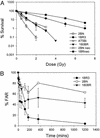Nonhomologous end joining and V(D)J recombination require an additional factor
- PMID: 12604777
- PMCID: PMC151363
- DOI: 10.1073/pnas.0437964100
Nonhomologous end joining and V(D)J recombination require an additional factor
Abstract
DNA nonhomologous end-joining (NHEJ) is the major pathway for repairing DNA double-strand breaks in mammalian cells. It also functions to carry out rearrangements at the specialized breaks introduced during V(D)J recombination. Here, we describe a patient with T(-)B(-) severe combined immunodeficiency, whose cells have defects closely resembling those of NHEJ-defective rodent cells. Cells derived from this patient show dramatic radiosensitivity, decreased double-strand break rejoining, and reduced fidelity in signal and coding joint formation during V(D)J recombination. Detailed examination indicates that the patient is defective neither in the known factors involved in NHEJ in mammals (Ku70, Ku80, DNA-dependent protein kinase catalytic subunit, Xrcc4, DNA ligase IV, or Artemis) nor in the Mre11/Rad50/Nbs1 complex, whose homologue in Saccharomyces cerevisiae functions in NHEJ. These results provide strong evidence that additional activities are crucial for NHEJ and V(D)J recombination in mammals.
Figures



References
-
- Taccioli G E, Rathbun G, Oltz E, Stamato T, Jeggo P A, Alt F W. Science. 1993;260:207–210. - PubMed
-
- Nussenzweig A, Chen C, da Costa Soares V, Sanchez M, Sokol K, Nussenzweig M C, Li G C. Nature. 1996;382:551–555. - PubMed
-
- Fugmann S D, Lee A I, Shockett P E, Villey I J, Schatz D G. Annu Rev Immunol. 2000;18:495–527. - PubMed
-
- Gellert M. Adv Immunol. 1997;64:39–64. - PubMed
-
- Jeggo P A. In: Advances in Genetics. Hall J C, Dunlap J C, Friedmann T, Giannelli F, editors. Vol. 38. San Diego: Academic; 1998. pp. 185–211.
Publication types
MeSH terms
Substances
Grants and funding
LinkOut - more resources
Full Text Sources
Molecular Biology Databases
Research Materials
Miscellaneous

